IAH 207 Midterm
1/61
There's no tags or description
Looks like no tags are added yet.
Name | Mastery | Learn | Test | Matching | Spaced |
|---|
No study sessions yet.
62 Terms
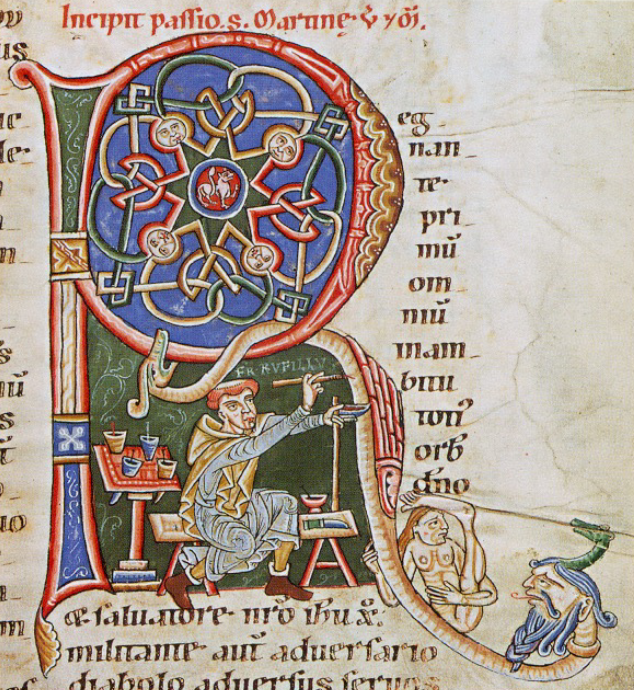
Brother Ruffilus Self Portrait
Brother Ruffilus
1100s
Unusual at the time and shows how the artist works in this context.
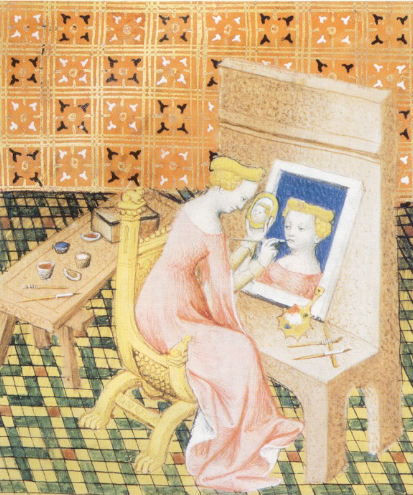
Marcia Painting Her Self Portrait
Anonymous
1400
Shows early biographies of women. Focused on where the mirror was placed. Shows the easels used at the time.
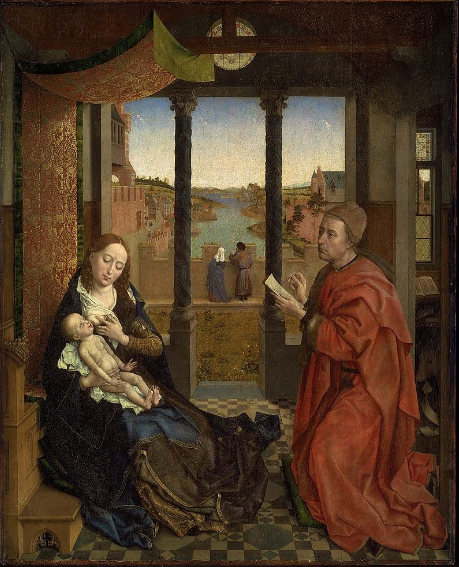
St. Luke Drawing the Virgin and Child
Rogier van der Weyden
1430
Connects art, artist, and everyday world to the divine. Use of perspective and connection to the natural world. Focus on hands.
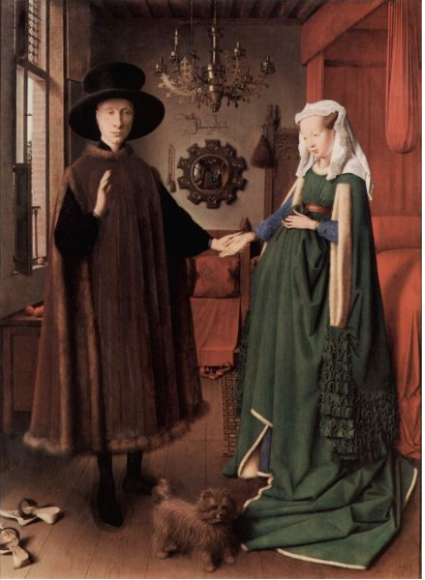
The Arnolfini Portrait
Jan van Eyck
1430
The large signature suggests van Eyck’s status. The Convex mirror is an important detail. Sense of humor in mixing religious and secular ideas.
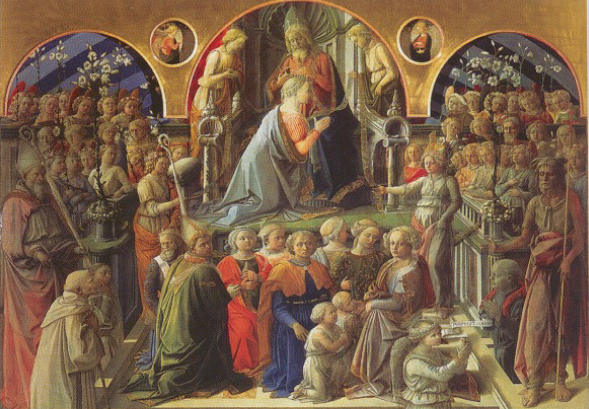
Coronation of the Virgin
Filippo Lippi
1430
Focus on gaze and hands. Renaissance interest in identities, emotions, expressions, etc. Connects artist to the divine. Artist directs his gaze at the viewer.
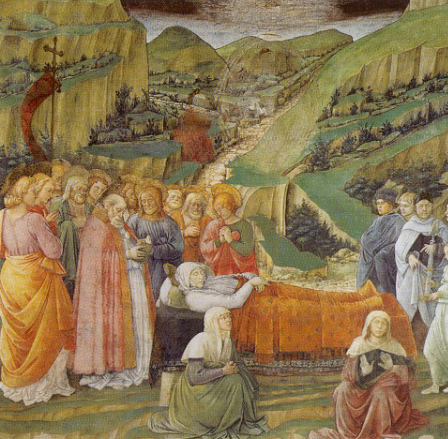
Dormition and Assumption of the Virgin
Filippo Lippi
1460
Focus on gaze and hands. Renaissance interest in identities, emotions, expressions, etc. Connects artist to the divine. Natural elements display the natural world.
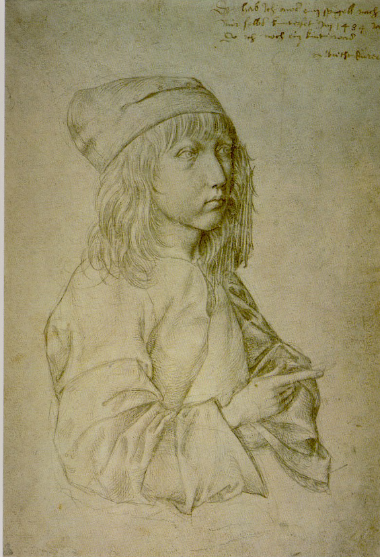
Self Portrait at 13
Abrecht Durer
1480
Portrait made in silverpoint. Shows artists skill at a young age. Made in a mirror. Shows ¾ - 2/3 perspective.
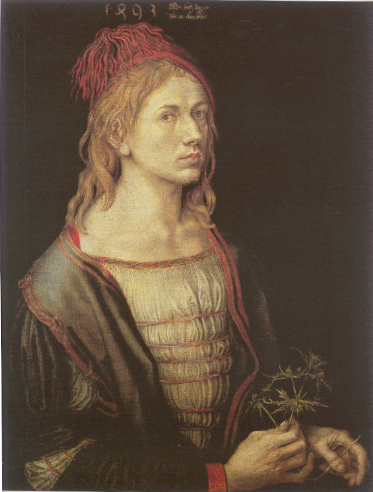
Self Portrait of the Artist with a Thistle
Abrecht Durer
1490
Connection to religion. Shows the artist as suffering like Jesus (thistle). Mirror perspective.
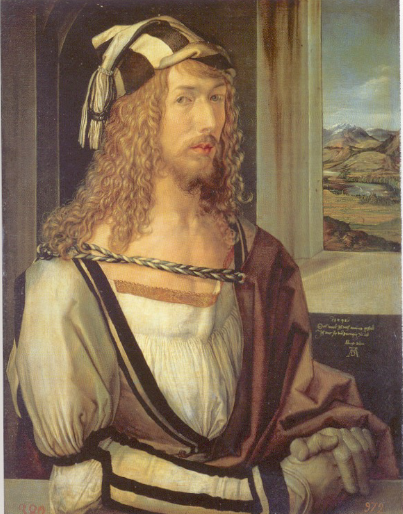
Self Portrait with Gloves
Abrecht Durer
1500
Shows himself as a noble. Clothing choice seen as not masculine. Italian landscape. Pose suggests this portrait was painted from a mirror. Detail in clothes
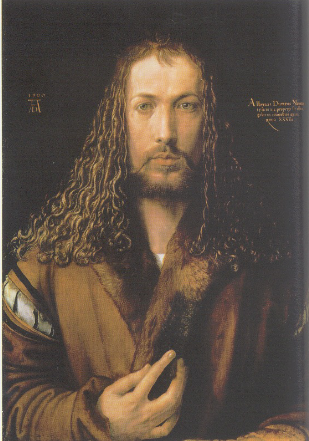
Self Portrait 1500
Abrecht Durer
1500
Poets wrote about this portrait and lovers sent it to each other. Self as both and icon and as himself. Painting each individual hair. Straight on portrait. Unique self branding.
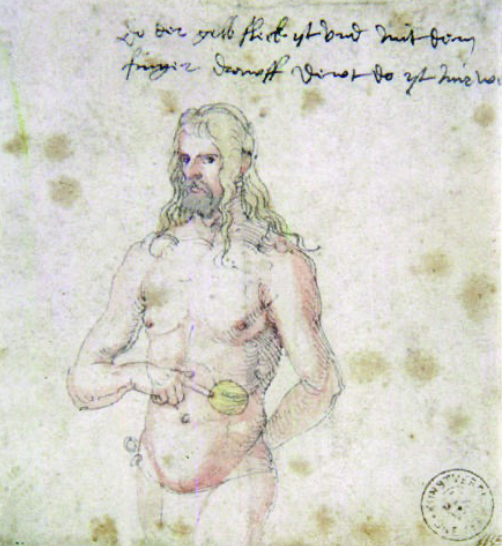
Self Portrait of the Sick Durer
Abrecht Durer
1510
Predicts modern pain mapping used in WW2. Self portrait but also anatomical practice. Men being painted in the nude was unusual for the time. ¾ view.
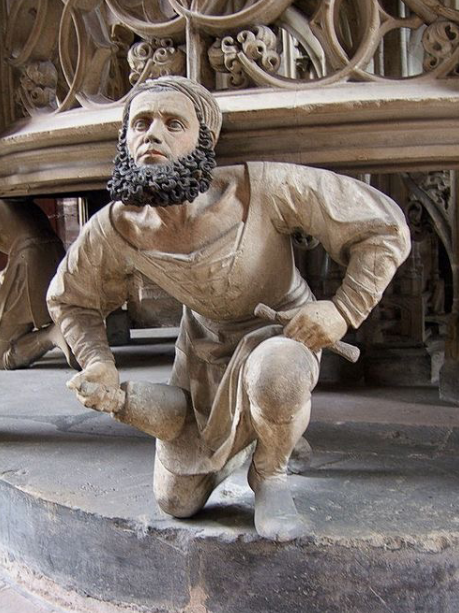
Self Portrait at the Foot of the Tabernacle
Adam Kraft
1500
Heroic self-portrait on an epic scale. Sculptural ingenuity and innovation suggests increased status of the artist (holding the sculpture up on his back). Self-portrait as a signature with larger work.
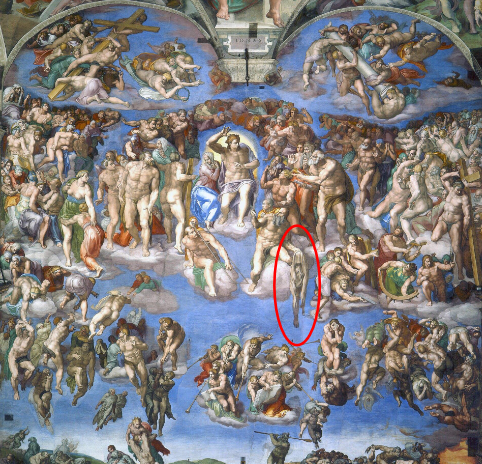
The Last Judgment
Michelangelo
1540
Deliberate uglification of self. Grotesque caricature. Use of role playing to reference personal subplots. Underplaying the value of the artists in a religious scene as a mere sinner.
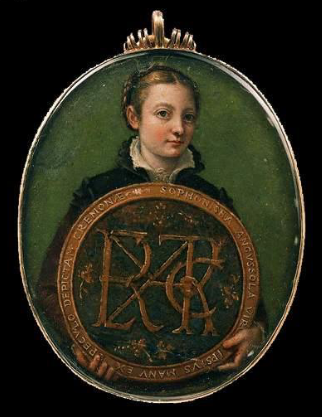
Self Portrait
Sofonisba Anguissola
1560
Was able to make portraits despite problems accepting female artists at the time. Portrait shows her devotion to her father who supported her. Medallion reads that this portrait was painted form a mirror.
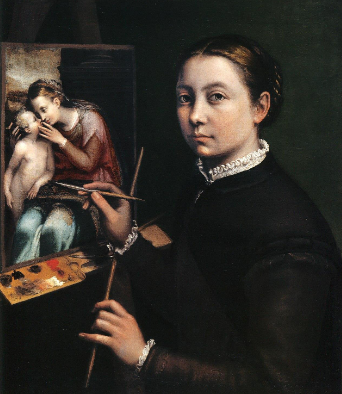
Self Portrait at the Easel Painting a Devotional Panel
Sofonisba Anguissola
1560
She embraces being the artist at work. Accentuates her own business persona. Shows she can paint religious scenes. Tools used by artists are accentuated.
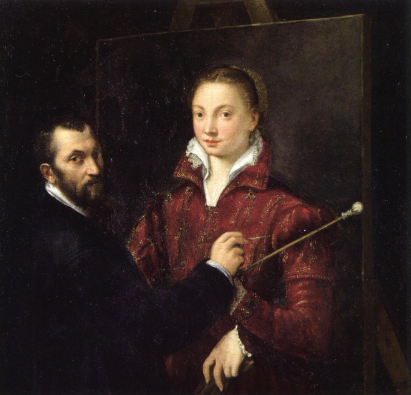
Self Portrait as a Portrait Created by Bernadino Campi
Sofonisba Anguissola
1560
Sustained and Inventive use of self-portraiture. Innovative new motifs. Playful subversion of gender roles and expectations. Sustained development of “artist at work” idea. Use of self portrait for career advancement and promotional purposes. Exploration of self in old age.
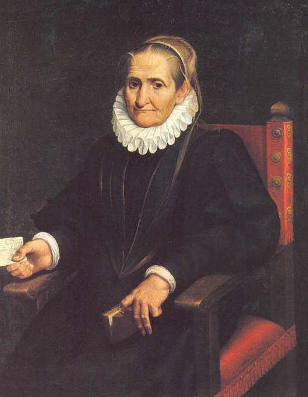
Self Portrait
Sofonisba Anguissola
1610
Exploration of self in old age. Mirror view. Self promotional self portraits. Used innovative and new motifs.
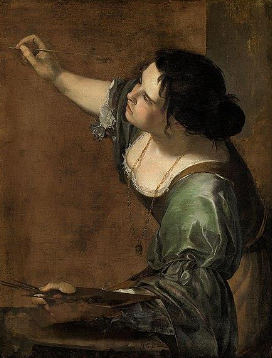
Self Portrait as an Allegory of Painting
Artemisia Gentileschi
1640
Allegorical Self Portraiture: Takes advantage of use of Women as Icons to deliver messages about gender (self=symbol). Role-Playing / Self Othering. Expressive Brushwork. Dynamic Compositions with strong lighting and dramatic chiaroscuro. Baroque focus on theatricality and drama. Strong female identities and roles Use of autobiographical self-portraiture.
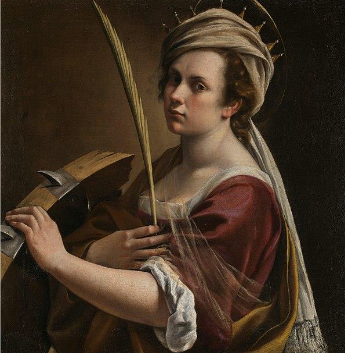
Self Portrait as St. Catherine of Alexandria
Artemisia Gentileschi
1620
Allegorical Self Portraiture: Takes advantage of use of Women as Icons to deliver messages about gender (self=symbol). Role-Playing / Self Othering. Expressive Brushwork. Dynamic Compositions with strong lighting and dramatic chiaroscuro. Baroque focus on theatricality and drama. Strong female identities and roles Use of autobiographical self-portraiture.
Chiaroscuro
Artistic technique of heightened contrast between light and dark which helps to give a sense of depth to oil paintings.
Baroque
The grand and highly decorated style used in European architecture, art and music in the 17th and early 18th centuries that was invented to create a sense of heightened emotions and awe.
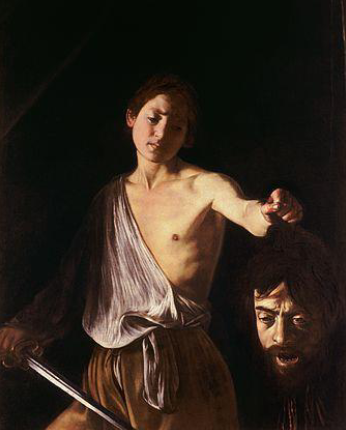
David with the Head of Goliath
Caravaggio
1610
Representation of the self as a victim. Interest in dramatic and violent moments. Loose and spontaneous use of paint. Interest in role-playing.
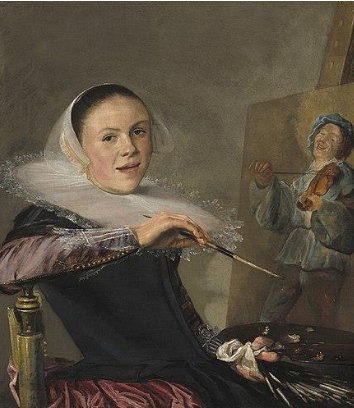
Self Portrait
Judith Leyster
1630
Confident and relaxed woman at work. Expressive brush strokes. Humor in her clothing choice. Humor in where she subtly points the paintbrush. Self fashioning.
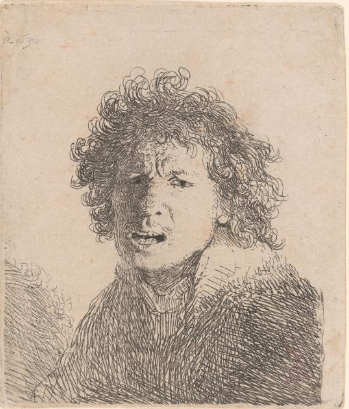
Self-portrait open mouthed shouting
Rembrandt
1630
Wild hair and lines on his young face. Powerful gaze. Extremes of light and dark. Artist as an outsider wanting to be heard.
Tronies
Studies of facial expressions for artists and later a wider public.
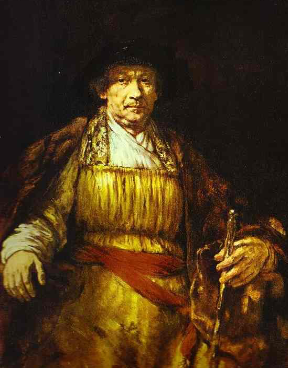
Self-Portrait
Rembrandt
1660
Painting himself as a historical figure. Used style to compensate for aging. Susanna’s boyfriend’s preferred painting.
Portrait Historie
Painting a portrait of a person as a historical figure.
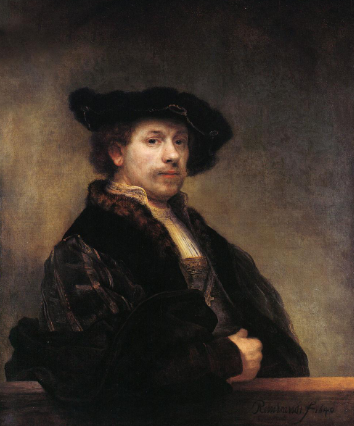
Self-Portrait at 34
Rembrandt
1640
Paints himself as “having arrived”. Clothes are expensive but out of fashion. Skin, hair, and clothes are done very well. Contrast between light and dark.
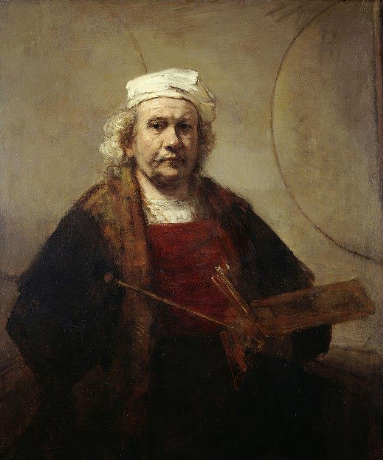
Self-portrait
Rembrandt
1660
Direct gaze is unusual. Eyes still bright but sad. Skin sags. Shabby clothes of the working artist. Mystery of the two circles.
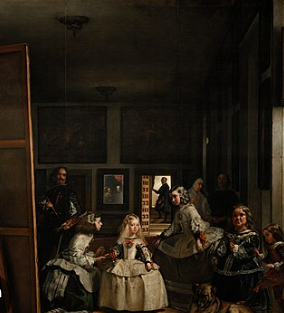
Las Meninas - The Ladies in Waiting
Diego Velazquez
1660
Ambitious scale. Self portrait alongside royals (daring). Unusual that servants are also central to the piece. Art itself is thought to be the painting’s ultimate focus. Loose handling of paint to capture textures and surfaces. Royale family in a domestic setting.
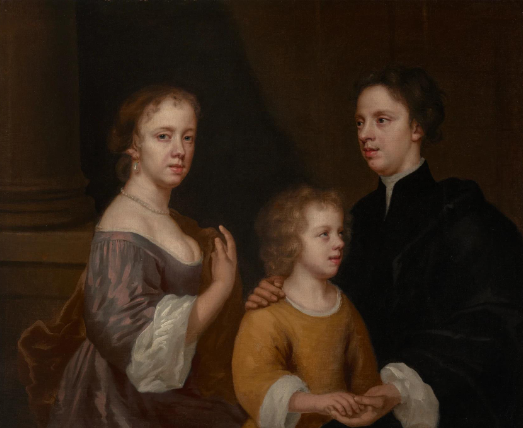
Self Portrait with her Husband Charles and Son Bartholomew
Mary Beale
1660
Representing a working mother. Self portrait with family. Confident view of women. Advertises her skill.
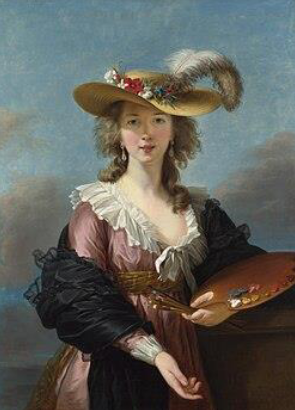
Self-portrait with Straw hat
Elisabeth Louise Vigee Le Brun
1780
Forges identity as female artist. Confident and attractive woman. Trend setting fashion. Deliberate relaxed informality and ease of haze.
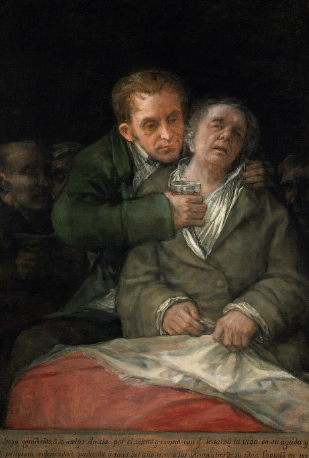
Self Portrait with Dr. Arrieta
Francisco Goya
1820
Focus on hands. No direct gazes. Interest in darker psychological states. Dramatic presentation of a moment of crisis. Unidealized representation of self.
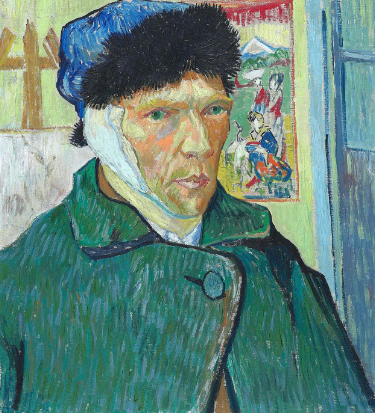
Self-portrait with Bandaged Ear, Easel, and Japanese Print
Vincent Van Gogh
1890
Gaze moves from hot and intense to cold in portraits. Expressive colors and brushwork shows emotional state. Outlines as a part of Japanese culture. Representation of the artist as an outsider.
Expressionism
A style in art, music, or drama in which the artist or writer seeks to express the inner world of emotion rather then external reality.
Neoexpressionism
Expressionism experimenting with color and form - often increasing use of paint on the canvas.
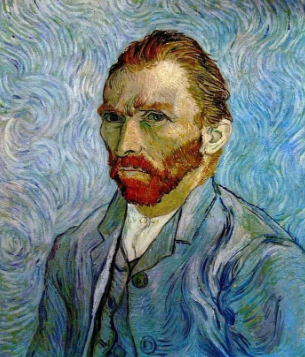
Self-portrait with Blue Background
Vincent van Gogh
1890
Gaze moves from hot and intense to cold in portraits. Expressive colors and brushwork shows emotional state. Outlines as a part of Japanese culture. Representation of the artist as an outsider.
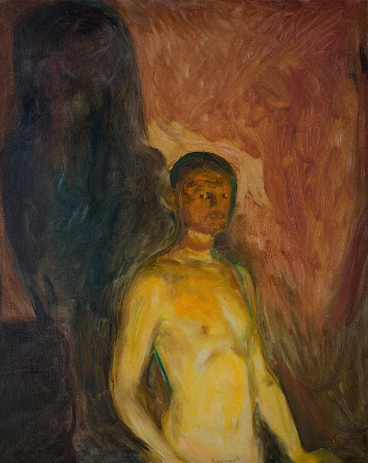
Self-portrait in Hell
Edvard Munch
1900
Made over 100 self portraits. Famous for his sense of trauma and anxiety. Dramatic backgrounds and looming shadows as a theme. Troubled by independent and powerful woman. Expressive dramatic colors. Painting men in the nude is rare.
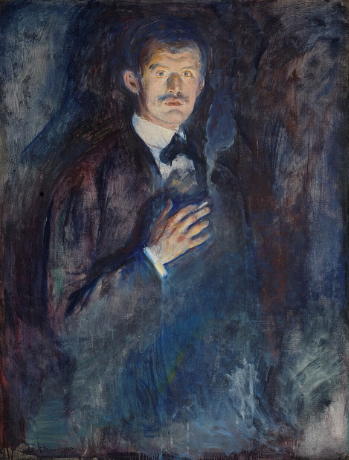
Self Portrait with Burning Cigarette
Edvard Munch
1900
Made over 100 self portraits. Famous for his sense of trauma and anxiety. Dramatic backgrounds and looming shadows as a theme. Troubled by independent and powerful woman. Expressive dramatic colors. Painting men in the nude is rare.
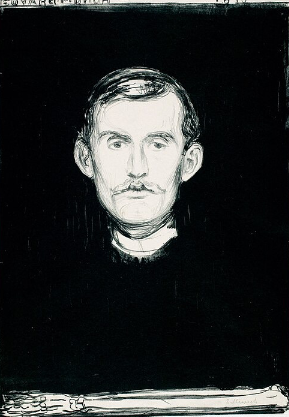
Self Portrait with Skeleton Arm
Edvard Munch
1900
Made over 100 self portraits. Famous for his sense of trauma and anxiety. Dramatic backgrounds and looming shadows as a theme. Troubled by independent and powerful woman. Expressive dramatic colors. Painting men in the nude is rare.
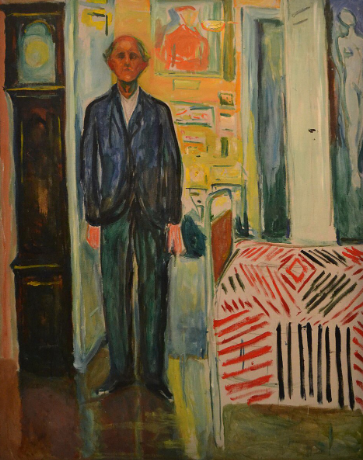
Between the Clock and the Bed
Edvard Munch
1940
Gaze is simple with style suggesting influences from Van Gogh. Grandfather clock references mortality. Blue colors show “the blues”. Room intentionally represents Van Gogh’s paintings.
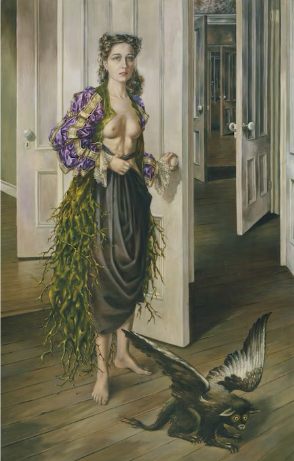
Birthday
Dorothea Tanning
1940
Explores her surrealistic self. Gaze is uncannily neutral. Assertive empowered feminist pose, shows control over the female nude.
Surrealism
Unlock the subconscious mind by creating dreamlike and illogical scenes.
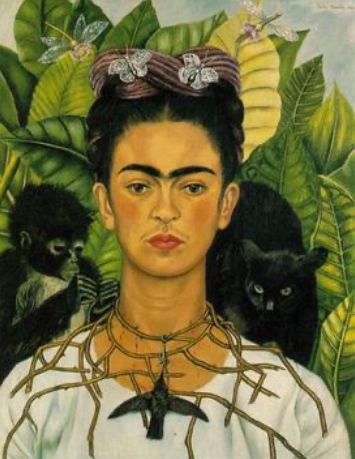
Self-Portrait with Thorn Necklace and Humming Bird
Frida Kahlo
1940
Direct gaze despite pain and suffering. Allegory of the animals and plants to show empowerment. Embracing folk dress. Eyebrow similar to bird wings (freedom).
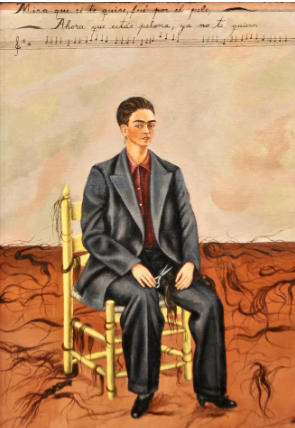
Self Portrait with Cropped Hair
Frida Kahlo
1940
Adopts Mexican style. Masculine dress. Hair is surrealistic and dreamlike. Cuts hair despite her husband loving her long hair.
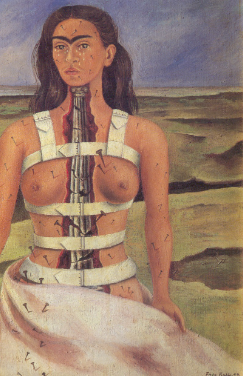
The Broken Column
Frida Kahlo
1940
Shows her broken body through injuries sustained. The column holds her together, similarly to how surgery held her together. Eyebrows like bird wings. Empowerment through nudity.
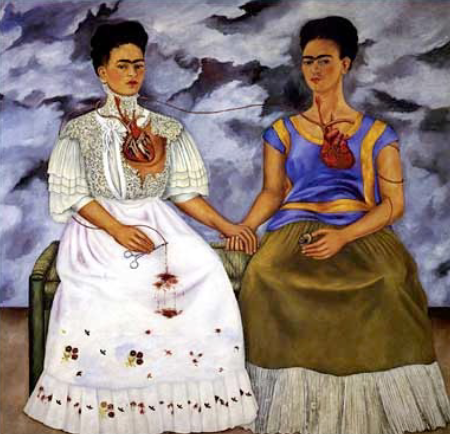
The Two Fridas
Frida Kahlo
1940
Shows her two personalities connecting. Holding surgical materials shows her trying to keep her body together. Connected eyebrows show bird symbolism.
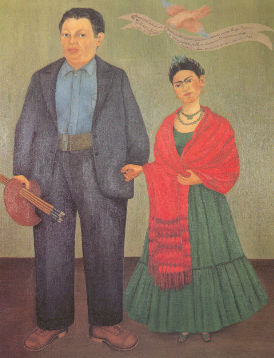
Frida and Diego
Frida Kahlo
1930
Painted for her friend. Similar to the Jan van Eyck painting through colors and poses. Bird symbolism.
Romanticism
Evoking emotional responses and establishes questions about modernity. The search for a lost state of nature.
Denaturing
The process which immersion in a culture leads people away from the attractive simplicity of a more neutral state.
Affect
How you deliver emotions on your face.
Sensibility
Strong response to an emotional and/or aesthetic situation.
Antithesis
Opposition or contrast of ideas or words in a balanced or parallel construction (direct opposite).
Amour Propre
Comparative self concept in which societal expectation override the indivudal’s nature. A sense of one's own worth.
Self Othering
Seeing the self as other, different, or exotic.
Renaissance Self-Fashioning
The process of constructing one's identity and public persona by consciously adopting and manipulating social standards, norms, and cultural products. Coined by literary scholar Stephen Greenblatt.
Autodidact
self taught
Deism
Believing in a monotheistic god but advertising a natural and rational religion.
Modernism
Modern artistic or literary philosophy and practice.
Flaneur
The strolling observer of social life and architecture. Reading the city.
Ethnography
Ethnography is a qualitative research method in the social sciences that involves immersing oneself in a specific culture or community to study and describe it through direct observation and participation.
Autoethnography
Autoethnography is a qualitative research method that combines autobiography and ethnography to explore cultural phenomena through personal experience.